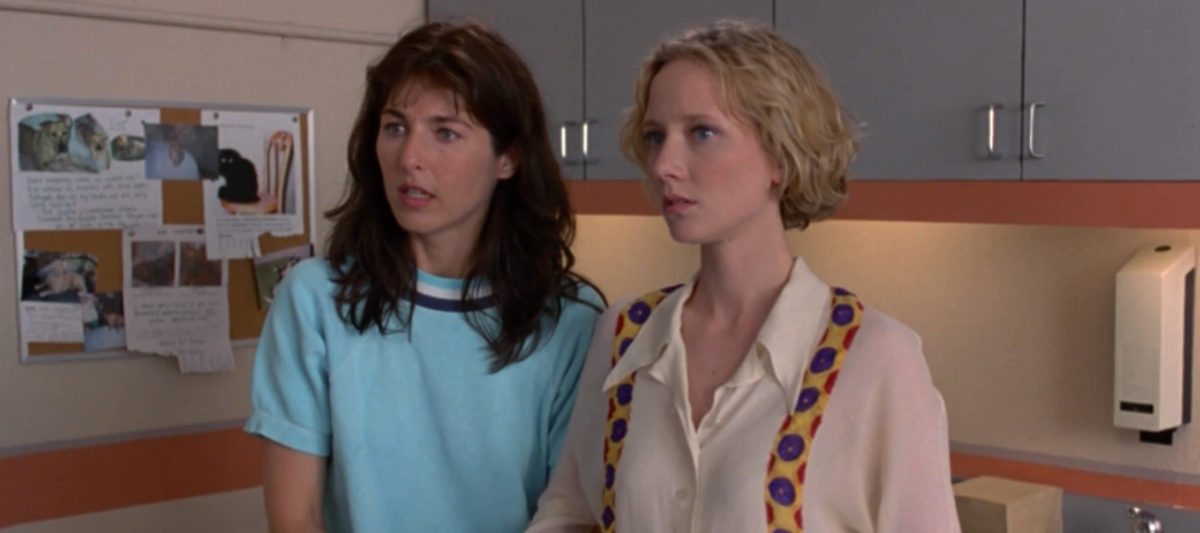Walking and Talking is a charming and humane little dramedy. It has well-sketched characters and sharp dialogue. It concerns contemporary adults trying to make order of messy friendships and relationships. Approximately three parts sweet to one part bitter. It is, in other words, a Nicole Holofcener film. Her debut, in fact. Every five years, almost on the button, the writer-director releases one of these, like a baker with her latest batch. The pastries are always delightful even if they’re never more than pastries; but you only go to this baker when that’s what you’re in the mood for.
The scenario this time resembles the last season of a long running sitcom: Amelia (Catherine Keener) and Laura (Anne Heche) are on the precipice of moving from “young adulthood” to “adulthood” — both have churned through an assembly line of ex-boyfriends and settled into a groove that’s bordering on a rut. Laura, a therapist who gossips and fantasizes a bit too much about her patients, gets engaged to her longtime, slightly boring boyfriend Frank (Todd Field). Amelia hangs out with her ex Andrew (Liev Schrieber), giving him advice on his long-distance romance. She feels lonely enough herself to ask out Bill (Kevin Corrigan), the dorky video store clerk who’s been hitting on her for years.

The film’s primary subject is the friendship between Amelia and Laura. We witness the easy but volatile comfort of a BFF with whom you never have to filter yourself. But something is different recently; there’s a growing distance between the two, especially in the wake of Laura’s engagement. Amelia is a bit panicky that Laura is getting married, worried that she’ll lose the emotional intimacy they share. She is also quietly envious of the latter’s career and romantic milestones. The way the two ebb and flow from each other scene-to-scene reminded me of my own adult friendships with people I’ve known since high school: I always want them in my life even if I occasionally feel like we’re headed down different paths.
Holofcener walks a fine line with Amelia and Laura: they both have off-putting characteristics and moments of nastiness, but are ultimately human and sympathetic. The friction between their occasionally-difficult personalities results in a stronger, healthier friendship, like cauterizing a wound before it gets too infected. Complex female relationships like this are not something we find every day in Hollywood films.
Holofcener resists the urge to make any of her characters the subject of an easy narrative: No one person has a hidden heart of gold just waiting to be discovered (with the possible exception of video-store “ugly guy” Bill who is given more dignity in the film’s second half than his near-caricature depiction in the first half); nor is anyone secretly more of a villain than they let on. People are people — we have highs and lows; we contain multitudes.

The cast has a lovable affability to it. Everyone is perfectly-suited to their character. I think if I was fifteen years younger, Catherine Keener would have been my Lizzy Caplan: a beautiful, hilarious, snarky, eternally underrated brunette whom I would follow to the ends of the Earth. I’m definitely adding some of her movies to my watchlist. Heche, who sadly died in a car crash last year after decades of struggling with mental health challenges, is also a revelation. She’s charming and prickly and just a little patronizing the way that successful people can sometimes be. Schreiber is cherubic and adorable even as he’s just a little sleazy. He easily could have starred in more rom-coms; he has the instant chemistry with everyone else on screen that the genre demands. And on down the line, every turn in the film feels pitch-perfect.
The film is set in New York City and has an inviting, autumnal coziness to it. It has that carefree pre-9/11 urban romanticism in it you often saw in ‘80s and ‘90s cosmopolitan romcoms and sitcoms. Lots of shots of characters roaming city streets and parks in sweaters. Unrealistically big apartments and offices. You know the style. See also: You’ve Got Mail, When Harry Met Sally, and about a million others. Its ’90s alt-rock soundtrack helps set the tone, too.
Walking and Talking makes it all look so easy, and that’s what’s so impressive: Everything about the film is in perfect sync and feels so lived in. Holofcener labored over the details of the script and production for years, and that polish shows. It’s too much of a trifle to be a capital-G great movie, but it’s honestly a bit closer than I would have guessed at the outset.
Is It Good?
Very Good (6/8)
Dan is the founder and head critic of The Goods. Follow Dan on Letterboxd. Join the Discord for updates and discussion.

